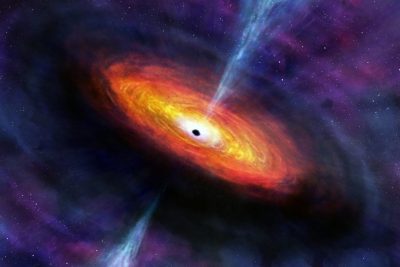
– Elaina Hancock – UConn Communications
Surveying millions of astronomical objects, such as supermassive black holes, is a huge and time-consuming undertaking. An international team of researchers, including UConn assistant professor and astronomer Jonathan Trump and graduate student Yasuman Homayouni, have been successful in improving and speeding up this complex task of surveying and mapping our skies, in a study published in the Astrophysical Journal.
“In one sentence, it’s a new, industrial-scale way to weigh large numbers of supermassive black holes,” says Trump.
The effort is part of the Sloan Digital Sky Survey, one of the most successful survey projects in the history of astronomy, which has produced the largest and most detailed three-dimensional maps of the Universe to date. Just like early map makers trying to better understand the planet we live on, modern mapping of galaxies, quasars, and supermassive black holes – the largest type of black hole, found in the center of almost all currently known massive galaxies – gives researchers insight into these phenomena and the Universe we live in. The Sloan Digital Sky Survey is creating as detailed a map as possible of a portion of our sky, and has already collected data on more than three million astronomical objects.
Trump and his colleagues are working toward this goal using a method called reverberation mapping on an especially large sample of distant galaxies with supermassive black holes. The technique measures the mass of the black holes by using light echoes of gas orbiting the black holes, far outside the ‘event horizon’ within which nothing can escape falling into the black hole. With this data, he says, black holes can be described very easily.
“Mass is fundamental,” Trump says. “Once you know the mass, you can calculate almost everything there is to know about a black hole.”
It is this ability to understand so much about black holes from knowing just their mass that makes them good mapping targets. Black holes are more than just rips in space and time, and more than vacuum cleaners sucking up everything that gets too close to their event horizons, Trump explains. There are tight connections between black holes and the galaxies they exist in, so knowing the mass of a black hole allows researchers to unlock more information about the galaxy itself. For example, as black hole mass increases, the galaxy’s mass also increases in lockstep. There is also evidence that black holes act as stabilizing forces within their galaxies, and if a black hole happens to be located close to a supernova, the black hole can act to disperse the heavy elements that are created only in these exploding stars throughout the galaxy.
But there is more to learn. “We know black holes are important and they matter for the rest of the Universe, but we still don’t know exactly why,” says Trump. “They are such strange beasts in our reality.”
Speeding up the Mapping Technique
One drawback of reverberation mapping is that it requires multiple observations, over extended periods of time. With so many astronomical objects to observe and only so much equipment capable of taking such detailed measurements, large-scale mapping of this kind has not previously been possible.
“This technique is hard to do,” says Trump. “You need a lot of very well calibrated observations.”
In addition to the sheer number of objects observed for this project, the light signals observed were at times very faint because their sources of emission are at such great distances.
However, this project’s sizable dataset has increased the sample of black holes with reliably known masses by two-thirds in the past year alone – by 44 quasars to be exact. These data are quickly building on decades of existing work that had around 60 well mapped, representing only the last few percent of the history of the Universe.
The reverberation mapping data have reached deeper, around six or seven billion light years away, looking at more distant black holes. And the future of the project will go even farther, Trump says, which will translate to going even farther back in the history of the Universe.
He draws an analogy to periods in a human life to explain the distances in space and time: “We published data on 44 well-characterized black holes at about the middle age of the Universe. We hope to get to 100 [black holes] at around a quarter of the Universe’s age, so equivalent to around its early adolescence or maybe even childhood. A lot of changes happen in adolescence and childhood for us, and the Universe went through a lot of changes at that age too.”
Read more in the Sloan Digital Sky Survey press release here.
This research was supported by funding from the National Science Foundation grant AST-1517113, and Trump’s research group has additional support from the National Aeronautics and Space Administration, NASA HST-GO-15260.